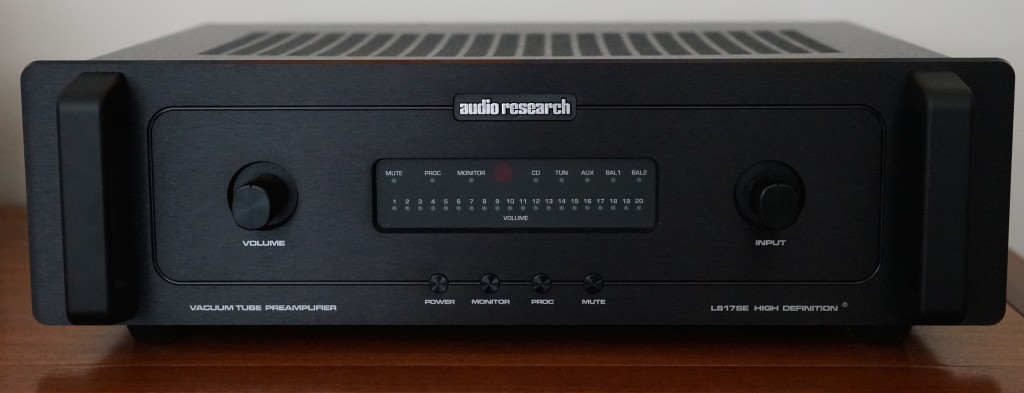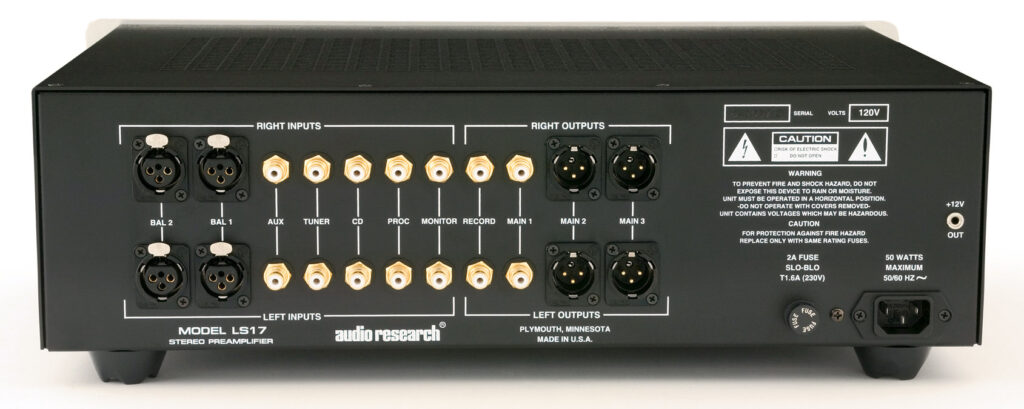The original Audio Research LS17 preamplifier was released in 2006 with a list price of $3,995. Using some of the same technology as the REF 3 and LS26 preamplifiers, the LS17 was targeted at a lower price point. The SE version hit the market in 2011 at $5,500. The upgrades in the SE version included “new Teflon coupling capacitors as well as other internal performance enhancements”.
The LS17 SE is called a “Hybrid JFET/Tube Stereo Line Stage” and has two 6H30 twin triode tubes in the Class A audio circuits. There are 7 inputs including 2 balanced inputs, and 4 outputs including a tape out, a single-ended output on RCA jacks, and 2 balanced outputs on XLR jacks. A welcome feature in this age of system integration is a remote trigger to turn on and turn off other components when the preamplifier is energized.
Other components on hand during the review period included a Basis 2500 Signature turntable with Vector 4 tonearm, a Miyajima Kansui and Zu Audio DL-103R phono cartridges, Lynx Hilo AD/DA converter, Wyred4Sound DAC-2 DSD SE DA converter, a Levinson 326S preamp with built in phono stage, Levinson No. 52 preamplifier, Ayre K-5xe MP preamplifier, YG Acoustics Kipod II Signature Main Modules speakers, Magnepan 1.7 and 3.7 speakers, Dali Mentor 5 speakers (from the home theater system), and two Gallo TR-3 and TR-3D subwoofers. Power amplifiers centered on the very satisfying Acoustic Imagery Atsah monoblocks. All front end components receive their AC power from a PS Audio Dectet which is connected to the wall power with a Shunyata Anaconda CX power cord. A PS Audio Quintet, connected to the utility grid with another slithering Anaconda CX, is normally used for the power amplifiers for power protection and remote turn on and turn off. A variety of power cords are used elsewhere in the system, including Wyred4Sound P1 and Jerry’s DIY power cords.

Audio Research is a stalwart brand of high end audio components that has been part of the audio scene since the beginning of time, it seems. Their top tier components are almost invariably included in short lists of reference quality gear. Over time, the Audio Research “house sound” has been more or less audible. This house sound is some degree of forwardness or highlighting of the upper midrange which gives music an apparent added excitement and presence. It is easily detected in bypass tests, which, for a balanced preamplifier, are almost ridiculously simple to perform. Just unplug the input and output XLR connectors from the preamp and connect them together. Done! Oh, there is just one detail. Make sure you can control the volume of the source component so you don’t send a full volume signal to the power amplifier. This is also easy to do with software on music computers but should be tested prior to removing any cables from the preamp!
Interestingly, the 6H30 tube seems to have some of this same sonic character, but presents it quite differently. The several components I have tested that used the 6H30 tube have all displayed a small inconsistency in their harmonic depth or tonal balance in the far upper midrange and lower treble that makes this region sound a bit dry and thin and cool. But that’s just my opinion which has been in the minority on one or two occasions in the past. Many people love the 6H30 tube’s clear and dynamic presentation.
Side note: My preferred preamp tube is the older Tesla 7DJ8, used in circuits designed for the popular 6922 tube. The 7DJ8 just sounds more real to me, and is relatively inexpensive at around $50-60 for a matched pair. Just at the end of the review, I installed a Cary DAC-100T DA converter and replaced the 6922 tubes with 7DJ8 tubes. With this DAC, the sound quality difference between the original LP playing on a turntable and a 24 bit 192 kHz digital recording of that same LP is suprisingly and almost irrelevantly small.
This is a good time to discuss a sonic bias that affects my observations here. The ARC preamps mentioned in this review have a unique sonic or tonal character that is different than heard from the Mark Levinson preamps or the Ayre preamp, or from many other brands. My sense is that the Levinson and Ayre “sound” is correct, offering no sense of highlighting or forwardness in any particular frequency range, and have very consistent resolution and tonal character from bass to treble.
The LS17 SE is a good match for the Magnepan 3.7 speakers. These speakers do not have true full range bass extension, but the LS17 SE seems to get them to sing lower and with more power than even the ’10 LP’ Levinson 326S. The bass quality is also excellent, providing the resolution to blend well with the lower midrange quality. The bass is richly saturated, presenting the vibration of strings and power of a bass drum very realistically. The bass performance never disappoints.
This excellent tonal quality extends into the midrange where voices, especially male vocals, are very believable and human. The small tonal discontinuity mentioned above affects most female vocals. Stringed instruments, from violins to guitars, and brass instruments, which have rich and complex harmonic overtones, are impacted to a fairly large degree by this anomaly. This same character was noted in our review of the Audio Research LS26. If the Audio Research “sound” is your thing, it is quite present.

There is very good extension and clarity in the upper treble without glare or harshness unless the recording includes some roughness. This extended treble is a common characteristic of the 6H30 tube and the LS17 SE lets it through undiminished. The soundstage is wide and almost as deep as with the Levinson 326S. The sound stage projects into the room very well.
There is truly outstanding clarity with complex music. All the bits and pieces of a full orchestra are properly sorted and the presentation never becomes just a barrage of sound. Musical crescendos really ‘pop’ and percussion is great: fast and detailed. Micro dynamics are also outstanding.
The preamplifier obviously has very low distortion, and a trace of self-noise or background hiss which is barely apparent when I stood next to a speaker was inaudible at the listening seat.
The volume steps on the trademark “row of lights” volume display are too large, often making it difficult to get just the volume level that was wanted. The LS17 SE usually went from “a little louder would be nice” to “this is too loud” with just one tap of the volume “Up” button. I may be spoiled by the 0.1 dB volume steps provided on the Levinson 326S preamplifier, but with this fine control, the listener always gets the optimum volume. The superb user interface and controls of the 326S system supplies what the listener needs and he does not have to adapt to the system and change his expectations. I had a hard time with the ‘row of lights’ volume indication, rarely confident that the volume setting was what I wanted. This might not be of concern to most listeners, but resetting the volume to a certain exact setting – useful for review and comparison purposes – seemed like an experiment. The numerical readouts on the 326S, LS26 and Ayre K-5xe MP preamplifiers are far more informative and user friendly. Ergonomics aside, the Ayre preamp, at $3,500, was preferred for long term listening enjoyment.
It may seem that I devote a lot of words to ergonomic issues, but a preamplifier is a component with which you interact frequently. If it is not easy to use, frustrating, or challenging, your mood will be affected which will, almost certainly, lessen the enjoyment you get from the listening session. Moving on…
One good example of excellent music from the LS17 SE is “Homeless” from Paul Simon’s Graceland LP. The musicians are presented very realistically on a 3-dimensional sound stage where the individual voices of the Ladysmith Black Mambazo singers are clearly differentiated and positioned behind Paul Simon on the stage.
The combination of huge dynamics and low distortion has a predictable effect: you turn up the volume. Your neighbors might complain and the indigenous wildlife scatter, but the LS17 SE offers an entertaining presentation and it is competitive at its asking price.
Overall Rating: 7 LPs (8 LPs, if you are into the ARC “sound”)
Link to manufacturer’s Web site: Audio Research
